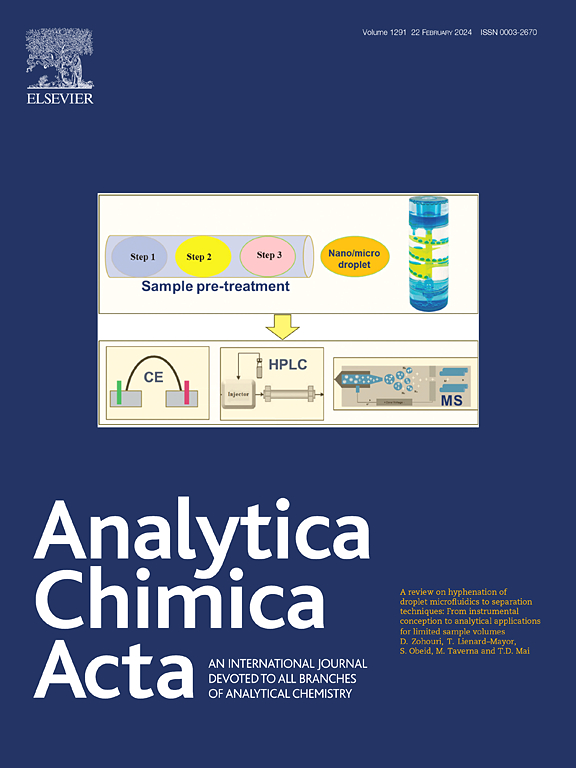A rapid portable assay for Salmonella typhimurium quantitative detection based on performance-enhancing anti-matrix interference aptamer
IF 5.7
2区 化学
Q1 CHEMISTRY, ANALYTICAL
引用次数: 0
Abstract
Background
Salmonella typhimurium (S. typhimurium) is a common cause of global foodborne illness, and poses a significant risk to food safety and public health. Consequently, there is a pressing need to develop a portable, rapid, quantitative and highly sensitive detection method for S. typhimurium to enable real-time field detection. Although aptamer-based detection methods for S. typhimurium have garnered increasing attention, challenges remain in improving their sensitivity, portability, and quantification accuracy. Additionally, the use of portable instruments for rapid quantitative detection is essential for successfully applying rapid testing methods in field-based quantitative analysis.
Results
In this study, two truncation strategies were employed to optimize the binding properties of the aptamer ROU-77 while maintaining its resistance to matrix interference. This optimization yielded a truncated aptamer, ROU-46, which exhibited a 4.2-fold increase in target affinity compared to ROU-77. Based on these findings, a novel variant probe which incorporated the aptamer and DNA bridges was designed to develop a signal amplified portable high affinity aptamer assay. The target concentration was converted into measurable glucose levels via the formation of DNA bridges, with signal amplification achieved by modulating the number of these bridges. Consequently, a portable glucose meter enabled highly sensitive, quantitative detection of S. typhimurium. Under optimized conditions, the assay achieved a detection limit of 295 CFU⋅mL−1. In addition, the excellent specificity, reproducibility, and practical applicability of this proposed method were carefully evaluated.
Significance
This study successfully truncated an anti-matrix interference aptamer and enhanced its affinity without compromising matrix resistance, which provided a novel strategy for aptamer optimization. Additionally, a new on-site detection method for S. typhimurium was developed by integrating the truncated aptamer into a composite probe and coupling it with a portable glucose meter. The use of the portable quantification device eliminated the need for large-scale equipment, and provided an innovative approach for real-time rapid detection.

基于增强抗基质干扰适配体的快速便携式鼠伤寒沙门菌定量检测方法
鼠伤寒沙门氏菌(S. typhimurium)是全球食源性疾病的常见原因,对食品安全和公众健康构成重大风险。因此,迫切需要开发一种便携式、快速、定量、高灵敏度的鼠伤寒沙门氏菌检测方法,实现现场实时检测。尽管基于适配体的鼠伤寒沙门氏菌检测方法已引起越来越多的关注,但在提高其灵敏度、便携性和定量准确性方面仍存在挑战。此外,使用便携式仪器进行快速定量检测对于在现场定量分析中成功应用快速检测方法至关重要。结果本研究采用两种截断策略优化了适配体rou77的结合特性,同时保持了其对基质干扰的抗性。该优化产生了截断的适配体,rou46,其靶亲和力比rou77提高了4.2倍。基于这些发现,我们设计了一种结合适体和DNA桥接的新型变异探针,以开发一种信号放大的便携式高亲和力适体检测方法。目标浓度通过DNA桥的形成转化为可测量的葡萄糖水平,通过调节这些桥的数量实现信号放大。因此,便携式血糖仪使高灵敏度,定量检测鼠伤寒沙门氏菌。在优化条件下,该方法的检出限为295 CFU·mL-1。此外,还对该方法的特异性、重现性和实用性进行了详细评价。本研究成功截断了一个抗基质干扰适配体,并在不影响基质抗性的情况下增强了其亲和力,为适配体优化提供了一种新的策略。此外,将截断的适体整合到复合探针中,并与便携式血糖仪耦合,建立了一种新的鼠伤寒沙门氏菌现场检测方法。便携式定量装置的使用消除了对大型设备的需求,并为实时快速检测提供了一种创新方法。
本文章由计算机程序翻译,如有差异,请以英文原文为准。
求助全文
约1分钟内获得全文
求助全文
来源期刊

Analytica Chimica Acta
化学-分析化学
CiteScore
10.40
自引率
6.50%
发文量
1081
审稿时长
38 days
期刊介绍:
Analytica Chimica Acta has an open access mirror journal Analytica Chimica Acta: X, sharing the same aims and scope, editorial team, submission system and rigorous peer review.
Analytica Chimica Acta provides a forum for the rapid publication of original research, and critical, comprehensive reviews dealing with all aspects of fundamental and applied modern analytical chemistry. The journal welcomes the submission of research papers which report studies concerning the development of new and significant analytical methodologies. In determining the suitability of submitted articles for publication, particular scrutiny will be placed on the degree of novelty and impact of the research and the extent to which it adds to the existing body of knowledge in analytical chemistry.
 求助内容:
求助内容: 应助结果提醒方式:
应助结果提醒方式:


